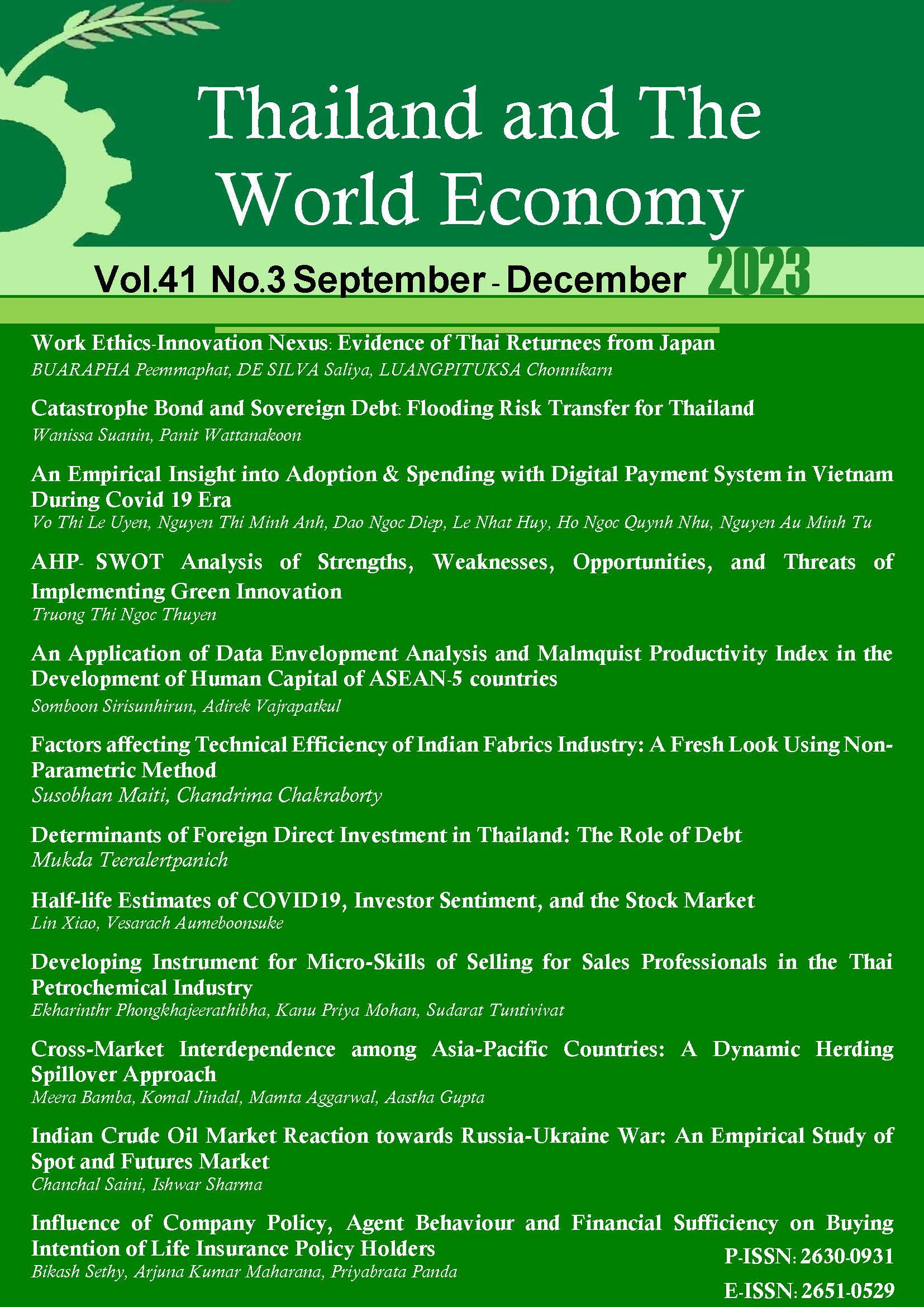Catastrophe Bond and Sovereign Debt: Flooding Risk Transfer for Thailand
Keywords:
Thailand, flooding, catastrophe bond, debt dynamicsAbstract
The dangers posed by natural disasters are a source of concern for policymakers. Severe occurrences caused by the devastation may contribute to the economic collapse and increase in sovereign debt. A catastrophe bond (CAT bond) can be utilized to transfer catastrophe risk to the financial market. This article examines how policymakers can use a CAT bond as an ex-ante financial instrument to raise funding. By using Thailand as a case study, this research replicates the loss caused by floods using three potential catastrophe bond packages based on the coverage size of the simulated loss. We find that all packages can slow the rising trend of the debt-to-GDP ratio under catastrophic flooding. Even if it cannot, on average, reduce the debt-to-GDP ratio, the greatest coverage bond provides the government with the highest level of utility since it can help mitigate the economic collapse during disaster seasons.
References
Adena, I., Hartwigb, K., & Rindermanna, G. (2009). (2009). Cedants’ perspectives on non-life securitization. In P. Barrieu & L. Albertini (1st Ed.), The Handbook of Insurance-Linked Securities (pp. 21-28). Hoboken, NJ: Wiley.
Aon Benfield. (2012). 2011 Thailand floods event recap Report. Impact Forecasting LLC, Aon Benfield: Chicago, IL.
Cebotari, A., & Youssef, K. (2020). Natural disaster insurance for sovereigns: Issues, Challenges and Optimality. IMF Working Paper, No.20/3. Retrieved from https://ssrn.com/abstract=3545292
Cummins, J. (2008). Cat bonds and other risk‐linked securities: State of the market and recent developments. Risk Management and Insurance Review, 11(1), 23-47.
Cummins, J. (2012). CAT bonds and other risk-linked securities: Product design and evolution of the market. Available at SSRN: https://ssrn.com/abstract=1997467. Or Retrieved from http://dx.doi.org/10.2139/ssrn.1997467
DHI (2012). Thailand floods 2011–The need for holistic flood risk management. Singapore: DHI-NTU Research Centre.
Ghosh, A., Kim, J., Mendoza, E., Ostry, J., & Qureshi, M. (2013). Fiscal fatigue, fiscal space and debt sustainability in advanced economies. The Economic Journal, 123(566), F4-F30.
Hagedorn, D., Heigl, C., Müllera, A., & Seidler, G. (2009). (2009). Choice of triggers. In P. Barrieu & L. Albertini (1st Ed.), The Handbook of Insurance-Linked Securities (pp. 21-28). Hoboken, NJ: Wiley.
Litzenberger, R., Beaglehole, D., & Reynolds, C. (1996) Assessing catastrophe reinsurance-linked securities as a new asset class. Journal of Portfolio Management, 23(5), 76-86.
Ostry, J., Ghosh, A., Kim, J., & Qureshi, M. (2010). Fiscal space. IMF Staff Position Notes. Retrieved from https://www.imf.org/external/pubs/ft/spn/2010/spn1011.pdf
Sakai, A., Roch, F., Wiriadinata, U., & Fu, C. (2022). Sovereign climate debt instruments: An overview of the green and catastrophe bond markets. IMF Staff Climate Note, 2022/004.
Swiss Re. (2012). Natural catastrophes and man-made disasters in 2011. Sigma, No. 2. Retrieved from https://www.swissre.com/institute/research/sigma-research/sigma-2013-02.html
Thai Meteorological Department. (2022). The Climate of Thailand. Retrieved from http://www.tmd.go.th/en/archive/thailand_climate.pdf
Von Peter, G., Von Dahlen, S., & Saxena, S. (2012). Unmitigated disasters? New evidence on the macroeconomic cost of natural catastrophes. BIS Working Papers, No 394. Retrieved from https://www.bis.org/publ/work394.pdf
Downloads
Published
How to Cite
Issue
Section
License
Copyright (c) 2023 Thailand and The World Economy

This work is licensed under a Creative Commons Attribution-NonCommercial-NoDerivatives 4.0 International License.










